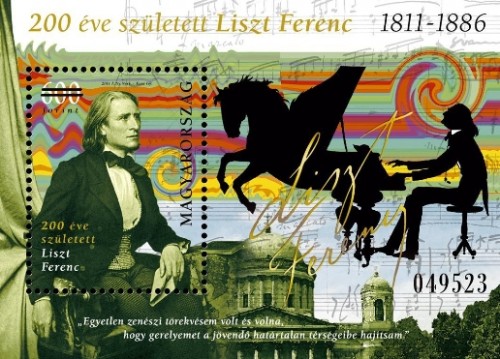
1. MAGYAR - JELES MAGYAROK: 200 ÉVE SZÜLETETT LISZT FERENC (1811-1886) BLOKK - Bélyeg rendelési kód: 2011 év bélyegei kompletten
2. ENGLISH - FAMOUS HUNGARIANS: BICENTERANY OF THE BIRTH OF FRANZ LiISZT - Order code of the stamp: 2011 Year stamps complete
3. GERMAN - - Die Bestellnummer Der Marke: 2011 Jahr Briefmarken komplett
1. MAGYAR - JELES MAGYAROK: 200 ÉVE SZÜLETETT LISZT FERENC (1811-1886) BLOKK
A Magyar Posta alkalmi bélyeg kibocsátásával köszönti Liszt Ferenc születésének 200. évfordulóját.
Liszt Ferenc a XIX. század egyik legjelentősebb romantikus zeneszerzője, minden idők egyik legnagyobb zongoraművésze. Első zongoraleckéit édesapjától kapta, aki maga is több hangszeren játszott. A tehetséges fiú soproni és pozsonyi koncertje idején még 10 éves sem volt, mikor gyönyörű játékával már közönségsikert aratott. 1822-ben apjával Bécsbe ment, ahol Carl Czernynél és Antonio Salierinél tanult. Mestereinél igen jó kezekben volt zenei fejlődése, de 1823 őszén Párizsban már magánúton folytatta tanulmányait. Fejlődését döntően befolyásolta a francia főváros szellemi és művész elitje. Pályafutása során több ízben adott jótékonysági koncertet, pl. a pesti árvíz károsultjainak javára, vagy a Nemzeti Zenede létesítésére is. Időközben karmesterként is bemu-tatkozott és a korábbi pergő élet korszakát a weimari karmesteri időszak váltotta, de miután megismerkedett Sayn-Wittgenstein hercegnével, Rómá-ba költözött, ahol főként egyházi zenék komponálá-sával foglalkozott, majd pedig az egyházi zene megreformálásán fáradozott. Ezt követően sokat utazott Róma, Weimar és Pest között. Egy ilyen utazás alkalmával meghűlt és életének 75. évében tüdőgyulladásban elhunyt.
Rendkívül termékeny zeneszerző volt. Mintegy 400 eredeti művének zöme virtuóz zongoramű, szimfónia, szimfonikus költemény, illetve mise. Közel 1400 művet komponált, mellyel minden idők egyik legtermékenyebb zeneszerzője lett. Zenei munkássága mellett rengeteg esszét is írt. Forrás: filharmonia.com, hu.wikipedia.org
A blokkon belüli bélyegkép Liszt Ferencet ábrázolja. A sorszámozott blokk keretrajzán montázsszerű grafikai megfogalmazásban a művész életét és munkásságát megörökítő kompozíció található. A bélyegképtől jobbra az Esztergomi Bazilika épületének részlete tűnik elő emlékeztetve Liszt Ferenc, a Bazilika felszentelése alkalmából komponált „Esztergomi mise” (1855) c. művére. A blokk keretrajzának főmotívuma a kor divatja szerinti árnykép, melyen a művész és a pegazussá változó zongora található. A montázs hátterében egy változó színcsíkokból álló, örvénylő, pulzáló szivárványsáv húzódik úgy, ahogy ma a számítógép vizuálisan képes megjeleníteni a zenét. A keretrajz alsó részén egy Liszt idézet olvasható: „Egyetlen zenészi törekvésem volt és volna, hogy gerelyemet a jövendő határtalan térségeibe hajítsam.” A montázs hátterében, alnyomatként a XIX. Magyar rapszódia kézirat első oldalának részlete látható (1885, Országos Széchényi Könyvtár, Ze-neműtár). A blokkot – hátoldali vakdombornyomás alkalmazásával – Liszt Ferenc arany fólianyomású aláírása díszíti. Az alkalmi borítékon egy képi metafora tűnik elő: Liszt időskori sziluettje zongorává alakul. Az alkalmi bélyegző grafikájának főmotívuma egy klaviatúra stilizált rajza.
Forrás: Posta
2. ENGLISH - FAMOUS HUNGARIANS: BICENTERANY OF THE BIRTH OF FRANZ LiISZT
Hungari Post is commemorating the 200th anniversary of the birth of Franz Liszt by issuing a special stamp.
Franz Liszt (Liszt Ferenc) was a major 19th-century Romantic composer and one of the greatest pianists of all time. He received his first piano lessons from his father, who also played a number of instruments. The talented boy was not yet 10 years old when he impressed the audience with his marvellous playing at concerts in Sopron and Bratislava (Pozsony). In 1822 he travelled to Vienna accompanied by his father, where he studied under Carl Czerny and Antonio Salieri. Although his musical education was in good hands, he continued his studies in the autumn of 1823 in Paris. The intellectual and artistic elite of the French capital greatly influenced his development. During his career he gave charity concerts on several occasions, e.g. for the benefit of the Budapest flood victims or to establish the Hungarian National Conservatory.
With the passage of time he made his debut as a conductor, and his hectic life as a touring virtuoso gave way to his period as a conductor in Weimar. After he met Princess Sayn-Wittgenstein, he moved to Rome, where he mainly composed sacred music before endeavouring to reform it. Thereafter he travelled a great deal between Rome, Weimar and Budapest. On one such journey he caught a cold and at the age of 75 died of pneumonia.
He was a highly productive composer. Most of his approximately 400 original works are virtuoso piano pieces, symphonies, symphonic poems and masses. He composed a total of about 1400 works and so became one of the most productive composers of all time. Apart from his musical oeuvre, he wrote numerous essays. Source: filharmonia.com, hu.wikipedia.org
The stamp design within the block depicts Franz Liszt. In the border of the numbered stamp block there is a montage-like graphic composition inspired by the composer’s life and work. To the right of the stamp design part of the building of Esztergom Basilica is shown, recalling that Liszt composed his Missa Solemnis for the consecration of the basilica in 1855. The main motif of the block’s border is the silhouette fashionable at the time showing Liszt the pianist with his instrument turning into Pegasus.
The background of the montage is composed of stripes of various colours, creating a whirling, pulsating rainbow similar to how music appears on a computer monitor today. In the bottom of the border there is a Liszt quotation: “My sole ambition as a musician has been and will be to throw my javelin into the infinite space of the future.” Part of the first page of the manuscript of the 19th Hungarian Rhapsody (1885, National Széchényi Library, Music Library) is used as the printing for the background of the montage. The block is adorned with Liszt’s signature printed in gold leaf by using reverse blind embossed printing. On the first day cover a pictorial metaphor appears, a silhouette of Liszt in later years transforming into a piano. The main motif of the commemorative postmark is a stylised drawing of a keyboard.
3. GERMAN -










